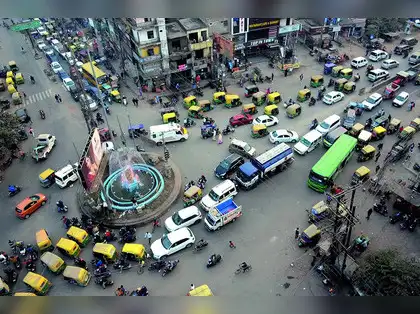
New Delhi, July 10, 2025 – India’s proposed Corporate Average Fuel Efficiency (CAFE) 3 norms, set to take effect in April 2027, aim to reduce passenger vehicle CO₂ emissions from 113 g/km under CAFE 2 to 91-95 g/km. While designed to curb fuel consumption and greenhouse gas emissions, these regulations have sparked significant debate for their potential to harm the small car segment, a cornerstone of affordable mobility in India. Critics, including industry leaders like Maruti Suzuki Chairman R.C. Bhargava and former Society of Indian Automobile Manufacturers (SIAM) president Rajan Wadhera, argue that the weight-based CAFE framework disproportionately penalizes lightweight, fuel-efficient small cars while favoring heavier, pricier vehicles like SUVs and electrified models. This could exacerbate affordability challenges, hinder mass motorization, and undermine environmental goals, particularly for India’s middle class.
Overview of CAFE Norms in India
Introduced in 2017 under the Energy Conservation Act, 2001, India’s CAFE norms regulate the fleet-wide average fuel consumption and CO₂ emissions for passenger vehicles under 3,500 kg, covering petrol, diesel, LPG, CNG, hybrid, and electric vehicles. The norms, enforced by the Bureau of Energy Efficiency (BEE), are calculated based on the corporate average kerb weight of a manufacturer’s fleet, weighted by sales volume, with CO₂ emissions directly proportional to fuel consumption (litres/100 km). The timeline includes:
- CAFE 1 (2017-2022): Targeted a 10% improvement in fuel efficiency, capping emissions at 130 g/km.
- CAFE 2 (2022-2027): Requires a 30% improvement, reducing emissions to 113 g/km.
- CAFE 3 (2027-2032): Proposes a further reduction to 91.7 g/km, with CAFE 4 targeting 70 g/km by 2032, using the Worldwide Harmonised Light Vehicles Test Procedure (WLTP).
Non-compliance incurs penalties of ₹25,000 per vehicle for exceeding fuel consumption by up to 0.2 litres/100 km, and ₹50,000 for higher exceedances, alongside additional fines for excessive CO₂ emissions.
Impact on Small Cars: Affordability and Market Challenges
India’s CAFE framework sets stricter CO₂ targets for lighter vehicles, as emissions limits scale linearly with kerb weight. For example, a small car weighing under 1,000 kg faces a tighter emissions threshold (e.g., ~90 g/km under CAFE 3) compared to a heavier SUV (e.g., ~140 g/km for a 1,712 kg fleet average, as seen with BMW). This structure disadvantages small cars, which are already fuel-efficient, emitting less CO₂ (e.g., Maruti Suzuki Alto at ~80-100 g/km) but struggle to meet increasingly stringent targets without costly technological upgrades.
Affordability Crisis
Small cars—defined as hatchbacks and sedans under 3.6 meters—are critical for India’s middle class, offering safer, weather-protected mobility compared to the 25 crore two-wheelers that account for 45% of road fatalities. However, their affordability has eroded:
- Price Surge: Entry-level car prices have risen from ₹2.5 lakh six years ago to ~₹5 lakh today, driven by high taxation (28% GST for small cars), rising insurance costs, and compliance with BS6 and CAFE norms.
- Sales Decline: Small car sales plummeted 71% from 460,772 units in FY19 to 133,397 in FY25, with a 77% drop over eight years, as regulatory costs push prices beyond the reach of entry-level buyers.
- Market Shift: Manufacturers like Maruti Suzuki, with 10 of 17 models under 1,000 kg, face pressure to pivot to SUVs or electrified vehicles, which benefit from relaxed targets and super credits (e.g., battery electric vehicles [BEVs] count as three sales, plug-in hybrids as 2.5).
Maruti Suzuki, holding a 40.9% market share, has lobbied for relaxed norms for cars under 1,000 kg, arguing that the current framework threatens the viability of affordable models like the Alto and Swift. Chairman R.C. Bhargava emphasized that small cars’ environmental benefits—lower fuel use, fewer raw materials, and reduced road wear—are undermined by policies favoring heavier vehicles.
Environmental Contradiction
Small cars align with India’s Mission LiFE initiative, promoting sustainable consumption through lower fuel use (e.g., 5-6 litres/100 km vs. 8-10 for SUVs) and CO₂ emissions. Yet, CAFE 3’s linear weight-based model penalizes their efficiency, discouraging lightweighting—a key decarbonization strategy. A Nomura report notes that global markets like the US, China, Japan, and Europe use flexible frameworks (e.g., piecewise linear or quadratic curves) that relax targets for smaller vehicles, ensuring equity and supporting mass mobility. India’s approach, modeled on outdated European norms, lacks such nuance, risking higher overall emissions as manufacturers shift to larger vehicles.
For instance, FY22-23 data shows fuel consumption for M1 category vehicles at 5.16-6.65 litres/100 km, with small cars contributing to CO₂ savings due to their efficiency. However, CAFE 3’s 91.7 g/km target could force manufacturers to prioritize electrified SUVs over small cars, increasing raw material use and production emissions.
Global Practices vs. India’s Approach
Unlike India, major automotive markets adopt frameworks that protect small cars
Last Updated on Thursday, July 10, 2025 2:49 pm by Lok Ram